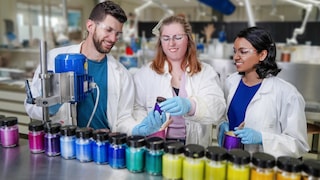
Innovation
People in Brazil now have a new ally in the fight against an invasive carrier of dengue fever – a powerful mosquito-repellent coating developed by our Coral brand.
It’s a great innovation which will benefit thousands of people. But how does the product (a transparent topcoat) work? How was it tested? And how safe is it?
It’s a clear matt varnish which can be applied over any painted interior wall. It contains an active ingredient called permethrin, a well-known repellent that’s commonly used in fabrics for mosquito nets and protective clothing. Its repellent action targets the Aedes aegypti mosquito, which transmits dengue, as well as the zika and chikungunya virus. These diseases pose a growing public health problem, not only in Brazil, but throughout the world. And because they don’t have a specific treatment, prevention is regarded as the best strategy.
Once a mosquito lands on a wall painted with the new product, the permethrin is absorbed through its legs and into the central nervous system. This triggers a reaction which causes the insect to disengage or fall off. So the more walls that are painted, the greater the repellent effect.
It was specifically tested to repel the Aedes aegypti mosquito.
The effectivness and safety of the product were fully tested in an independent external laboratory, certified by the Brazilian Network of Analytical Health Laboratories. To ensure its functionality in practice, the tests were conducted in a full-size house environment. The results showed that mosquitoes were repelled from the environment after contact with the protected walls – with the active ingredient being retained in the varnish matrix. The product was also certified by the Brazilian Health Regulatory Agency (ANVISA).
As required by ANVISA, toxicology studies and risk assessments were carried out to evaluate the exposure scenario and to prove that the product is safe. The product was specifically designed to avoid harming people or the environment, as required by ANVISA, and it also meets our own strict environmental standards. As with any paint or chemical product (in a liquid state), it should be kept away from children and animals, and must be used in accordance with the instructions and safety information described on the label. All the standard precautions relating to the disposal of paint must also be taken into account. To ensure optimal results, we recommend following all the steps outlined on the packaging.
A major advantage of the new product is that the active ingredient is “stuck” to the varnish matrix. That means it’s only released when a mosquito lands on the surface. It’s also only released in a quantity that affects the mosquito, not human beings or pets. This was extensively tested to prove that the product is safe.
The product gives protection 24 hours a day, for up to two years. The possibility of it being made available and launched in other countries will depend on local legal and regulatory assessments.
